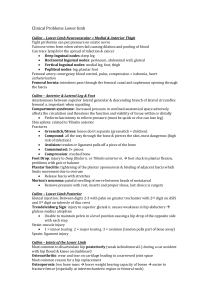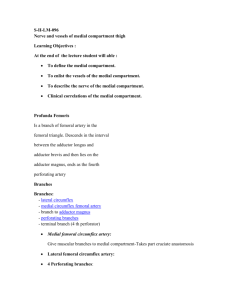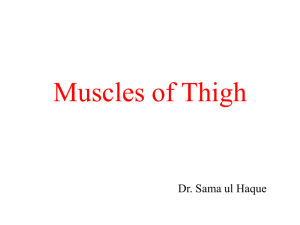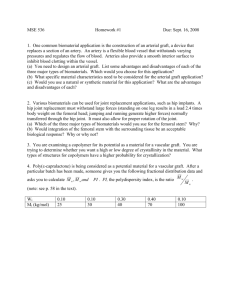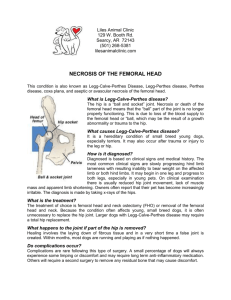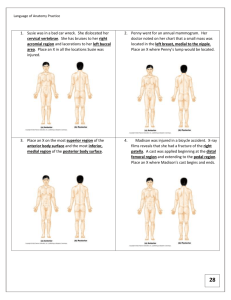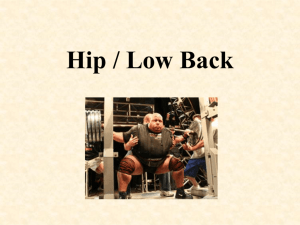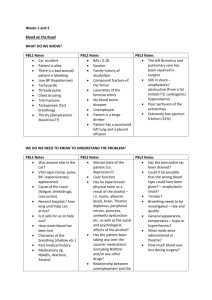Hip Joint
advertisement
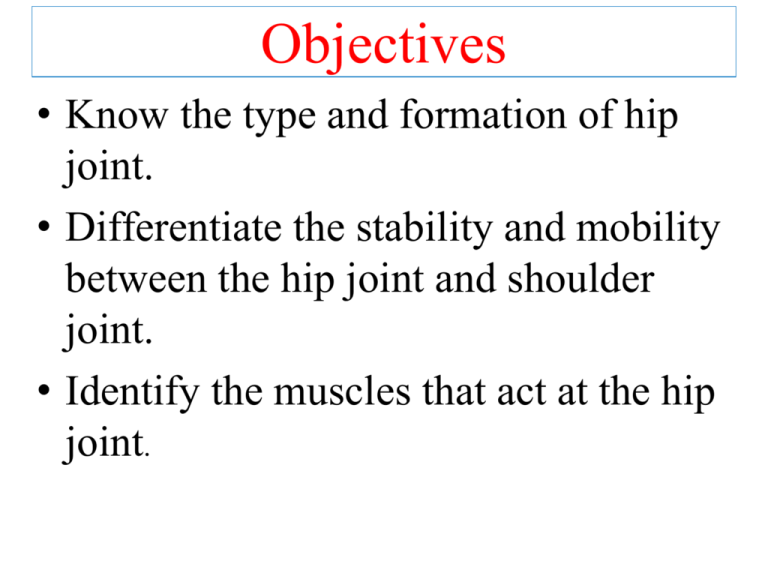
Objectives • Know the type and formation of hip joint. • Differentiate the stability and mobility between the hip joint and shoulder joint. • Identify the muscles that act at the hip joint. Hip joint • • • • • • • Is a synovial is a ball and socket joint. Articulation between the head of the femur and the acetabulum. The articular surfaces of the hip joint are: the spherical head of the femur. the lunate surface of the acetabulum. The nonarticular acetabular fossa contains loose connective tissue. The lunate surface and the head of the femur(except for the fovea) are covered by hyaline cartilage. Capsule • The hip joint is enclosed within strong fibrous capsule lined by synovial membrane . • Proximally, it is attached to the acetabulum, and to the transverse acetabular ligament . • Distally, it is attached to the femoral neck posteriorly and anteriorly to the intertrochanteric line. • The synovial membrane lines the capsule and the nonarticular surfaces. • It reflects along the femoral neck to the edge of the femoral head forming retinacula (longitudinal synovial folds). • The arteries that supply the femoral head and neck course within the synovial folds. Anterior Ligaments Posterior ischiofemoral iliofemoral crest line pubofemoral Note: neck is bare here Ligaments: Pubofemoral (medial), resists over abduction Iliofemoral (anterior), resists hyperextension Ischiofemoral (posterior), resists hyperextension The transverse acetabular ligament is formed by the acetabular labrum as it bridges the acetabular notch • Movements at the hip joint include: • Flexion. • Extension, • Abduction. • Adduction. • Medial and lateral rotation. • Circumduction. Hip Flexion Chief flexor of HIP: Iliopsoas Psoas major iliacus Insertion – lesser trochanter Femoral nerve (L2-L4): - Main innervation of anterior thigh. Obturator nerve (L2-L4): - Main innervation of medial thigh. Hip extension Gluteal region: Gluteus maximus iliotibial tract FYI gluteus maximus Tensor Fasciae Latae -Gluteus maximus (most powerful extensor, also lateral rotator) Insertion: Gluteal tuberosity + Iliotibial tract (band) Gluteus Maximus and Tensor Fascia Lata insert into Iliotibial Tract - Iliotibial tract is a thickening of the deep fascia (fascia lata) that extends from the ilium to the tibia. - Tension from contraction of gluteus maximus and tensor fasciae latae stabilizes the lower limb as a weight-bearing column. Hip Adduction Medial Compartment main function = adduction Obturator externus Adductor brevis Adductor longus Adductor magnus Gracilis obturator externus adductor brevis adductor longus obturator nerve Adductor magnus gracilis Most innervated by: Obturator nerve (L2-L4) (lumbar plexus) Exception: -Hamstring component of adductor magnus (extensor) (tibial division of sciatic nerve) Lateral Rotation of the hip gluteus medius gluteus maximus superior gamellus inferior gamellus gluteus minimus Deep to gluteus maximus: piriformis -abductors: gluteus medius obturator gluteus minimus internus (anterior fibres medially rotate) quadratus femoris -lateral (external) rotators: piriformis obturator internus (associated gemelli) quadratus femoris [obturator externus is also a lateral rotator] Femoral Triangle Boundaries: Inguinal ligament Sartorius (lateral) Adductor longus (medial) iliopsoas pectinius femoral nerve femoral artery sartorius Floor: Iliopsoas, pectinius, adductor longus Contents: femoral Femoral nerve vein Femoral artery & deep (profunda) femoral branch Femoral vein adductor longus Great saphenous vein (superficial), draining into femoral vein Lymphatics Summary: Movements of the Hip Joint (ball and socket). Flexion - Anterior + medial compartments of thigh (iliopsoas, sartorius, rectus femoris, adductor group) Extension - Gluteal region /posterior compartment of thigh (gluteus maximus, hamstrings, adductor magnus) Adduction - Medial (adductor) compartment of thigh Abduction - gluteus medius & minimus, Tenor Fascia Lata Rotation: Lateral - Gluteus maximus, lateral rotators Medial - anterior parts of gluteus medius & minimus, + Tensor Fascia Lata • Vascular supply to the hip joint is predominantly through branches of the: • obturator artery. • medial and lateral circumflex femoral arteries. • superior and inferior gluteal arteries. • first perforating branch of the deep artery of the thigh. The articular branches of these vessels form a network(anatomosis) around the joint . • The Trochanteric Anastomosis: • The trochanteric anastomosis provides the main blood supply to the head of the femur. • The nutrient arteries pass along the femoral neck beneath the capsule . • The following arteries take part in the anastomosis: • the superior gluteal artery. • the inferior gluteal artery. • the medial femoral circumflex artery. • and the lateral femoral circumflex artery. • The Cruciate Anastomosis • The cruciate anastomosis is situated at the level of the lesser trochanter of the femur. • The following arteries take part in the anastomosis: • the inferior gluteal artery. • the medial femoral circumflex artery. • the lateral femoral circumflex artery. • the first perforating artery, a branch of the profunda artery. • The hip joint is innervated by articular branches (Hilton’s Law) from: • the femoral. • obturator. • superior gluteal nerves • the nerve to the quadratus femoris. • sciatic nerve.
